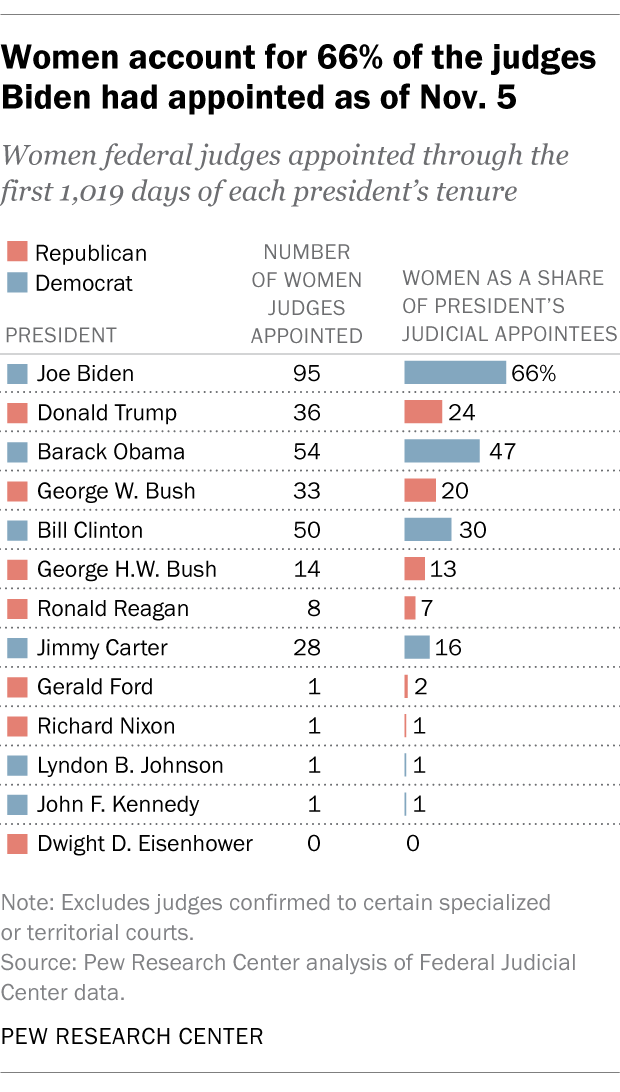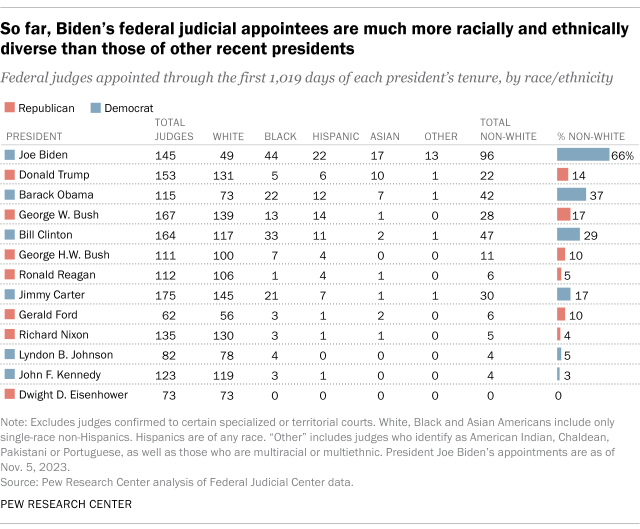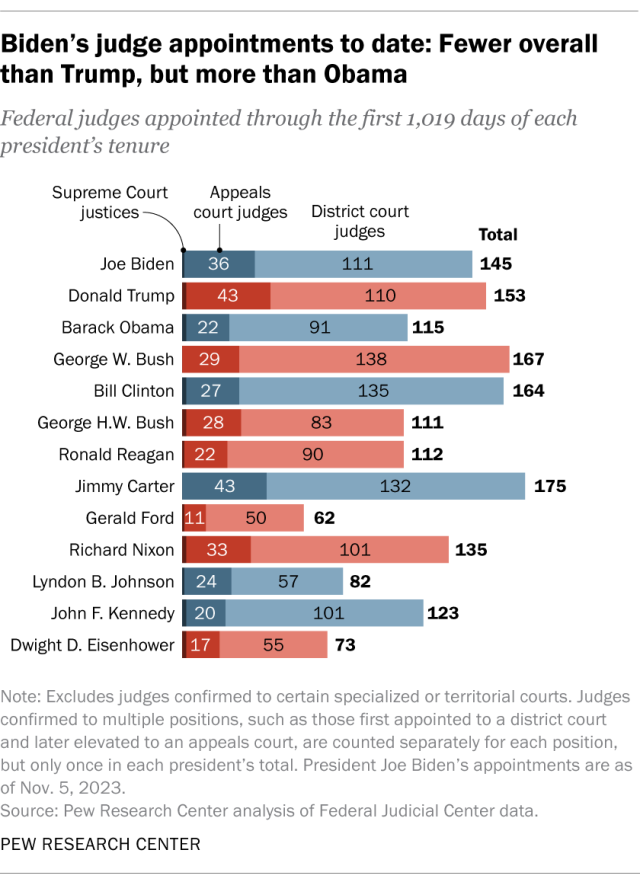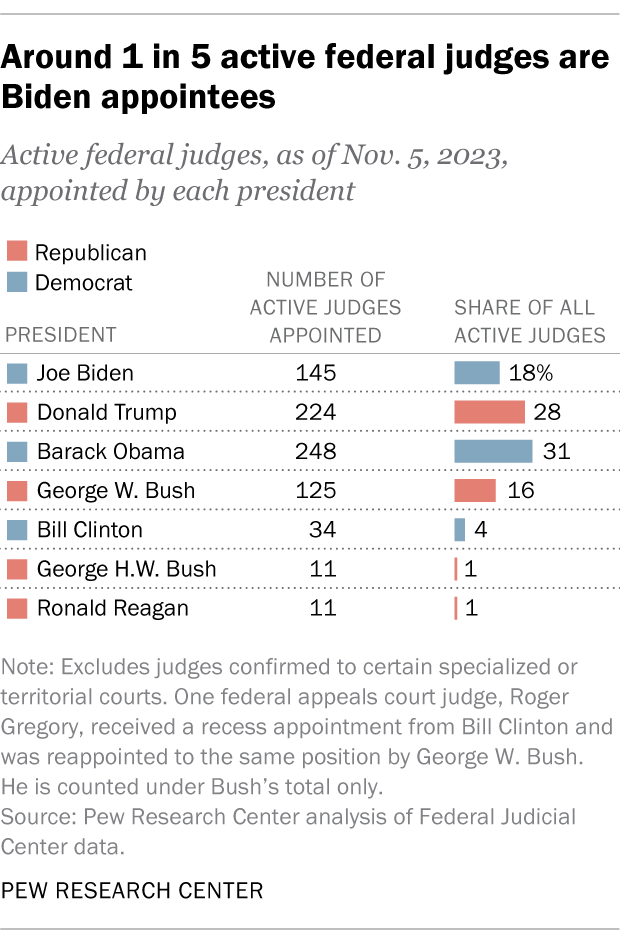
Nearly two-thirds of the federal judges President Joe Biden has appointed so far are women, and the same share are members of racial or ethnic minority groups, according to a Pew Research Center analysis of statistics from the Federal Judicial Center.
This Pew Research Center analysis examines how U.S. President Joe Biden compares with other recent presidents in the number and characteristics of the federal judges he has appointed to date. It is based on data published by the Federal Judicial Center, the research and education arm of the federal judicial branch.
The analysis focuses on judges appointed to the 91 district courts and 13 appeals courts that are governed by Article III of the U.S. Constitution, as well as those appointed to the U.S. Supreme Court. It excludes judges appointed to certain specialized courts, such as the U.S. Court of International Trade, as well as appointees to non-Article III territorial courts in Guam, the Northern Mariana Islands and the Virgin Islands.
To allow for an apples-to-apples comparison, the analysis looks at all judges confirmed by the U.S. Senate through the first 1,019 days of each president’s administration. For most presidents in this analysis, that translates to Nov. 5 of their third year in office. The exceptions are former Presidents Gerald Ford and Lyndon B. Johnson, both of whom were inaugurated for the first time on a date other than Jan. 20 and therefore reached the 1,019-day mark on a date other than Nov. 5 of their third year. This analysis begins with Dwight D. Eisenhower because he was the first president to be sworn in to a first term on the modern inauguration date of Jan. 20.
White judges in this analysis include only those who identify as single-race non-Hispanic, as reported by the Federal Judicial Center. Non-White judges include those who identify as Black, Hispanic, Asian, American Indian, Chaldean, Pakistani or Portuguese, as well as those who identify as multiracial or multiethnic.
Biden still has more than a year left in his term, so these patterns could change. But no president has ever appointed a slate of judges consisting mostly of women or racial and ethnic minorities.

To put Biden’s judicial appointments into historical context, we examined how his appointed judges to date compare with those of other presidents at the same point in their tenures, going back to Dwight D. Eisenhower in the 1950s. This analysis begins with Eisenhower because he was the first president to be sworn in to a first term on the modern inauguration date of Jan. 20.
As of Nov. 5 – exactly a year before the 2024 presidential election – Biden had appointed 145 judges to the three main tiers of the federal judicial system: the district courts, the appeals courts and the U.S. Supreme Court. Women accounted for just over 66% of those judges (95 of 145).
The 95 women judges Biden had appointed as of Nov. 5 far exceed both the number and share any other president had appointed at the same point in their term. For example, then-President Donald Trump had appointed 36 women judges by the same point four years ago (24% of his total at the time), while then-President Barack Obama had appointed 54 women judges (47% of his total at the time).
The pattern is similar when it comes to judges who are racial or ethnic minorities. Nearly two-thirds of the judges Biden had appointed as of Nov. 5 (96 of 145, or just over 66%) are Black, Hispanic, Asian American or members of another racial or ethnic minority group. That is far more than any other president had appointed at the same point in their tenure. Trump, for instance, had appointed 22 minority judges by the same stage (14% of his total at the time), while Obama had appointed 42 (37% of his total at the time).
Combining gender with race and ethnicity, women who are Black, Hispanic, Asian or part of another racial or ethnic minority group account for 42% of the judges Biden had appointed as of Nov. 5 (61 of 145). They include Biden’s sole appointee to the U.S. Supreme Court, Justice Ketanji Brown Jackson, the first Black woman to serve on the nation’s highest court.

How does Biden compare with other presidents in total judges appointed?

Biden does not especially stand out in terms of the overall number of federal judges he has appointed so far. He appointed 145 judges through Nov. 5 – fewer than Trump had appointed at the same point in his presidency (153), but more than Obama had (115).
Overall, Biden’s appointed judges include one Supreme Court justice (Jackson), 36 appeals court judges and 111 district court judges. Trump, by comparison, had appointed two Supreme Court justices by the same point in his tenure (Neil Gorsuch and Brett Kavanaugh), in addition to 43 appellate judges and 110 district judges.
Both Biden and Trump appointed some people to multiple judgeships. Biden, for example, appointed Jackson to an appeals court position before elevating her to the Supreme Court. In this analysis, these judges are counted separately for each position, but only once in each president’s total.
How many active federal judges were appointed by Biden?
Another way of looking at the effect that each president has had on the federal judiciary is to evaluate the share of currently active judges who were appointed by that chief executive.

As of Nov. 5, there were 798 active federal judges serving in the 91 district courts and 13 appeals courts governed by Article III of the U.S. Constitution, as well as on the Supreme Court. Biden had appointed 18% of those judges.
Of the federal judges who were active as of Nov. 5, larger shares were appointed by other recent presidents. Trump appointed 28% of active judges, while Obama appointed 31% and George W. Bush appointed 16%. Not surprisingly, relatively few judges who are still active today were appointed by presidents who served more than two decades ago – including Bill Clinton (4%), George H.W. Bush (1%) and Ronald Reagan (1%).
How many active federal judges were appointed by Democratic versus Republican presidents?
The current federal judiciary is closely divided between appointees of Democratic presidents, who comprise 54% of all active judges, and those chosen by Republican presidents, who account for 46%.
However, the breakdown varies by type of court. More than half of active judges in district courts were appointed by Democratic presidents (56%), while a smaller share (44%) were appointed by GOP presidents. The reverse is true in the appeals courts, where 53% of active judges were appointed by Republican presidents and 47% were appointed by Democrats. The Supreme Court consists of six justices appointed by Republican presidents and three justices appointed by Democrats, a 67%-33% split.
CORRECTION (Dec. 4, 2023): An earlier version of the chart titled, “Biden’s judge appointments to date: Fewer overall than Trump, but more than Obama” incorrectly identified former President George W. Bush as a Democrat.
Note: This is an update of a post originally published on Aug. 9, 2022.



